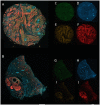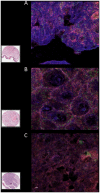Targets of Wnt/ß-catenin transcription in penile carcinoma
- PMID: 25901368
- PMCID: PMC4406530
- DOI: 10.1371/journal.pone.0124395
Targets of Wnt/ß-catenin transcription in penile carcinoma
Abstract
Penile squamous cell carcinoma (PeCa) is a rare malignancy and little is known regarding the molecular mechanisms involved in carcinogenesis of PeCa. The Wnt signaling pathway, with the transcription activator ß-catenin as a major transducer, is a key cellular pathway during development and in disease, particularly cancer. We have used PeCa tissue arrays and multi-fluorophore labelled, quantitative, immunohistochemistry to interrogate the expression of WNT4, a Wnt ligand, and three targets of Wnt-ß-catenin transcription activation, namely, MMP7, cyclinD1 (CD1) and c-MYC in 141 penile tissue cores from 101 unique samples. The expression of all Wnt signaling proteins tested was increased by 1.6 to 3 fold in PeCa samples compared to control tissue (normal or cancer adjacent) samples (p<0.01). Expression of all proteins, except CD1, showed a significant decrease in grade II compared to grade I tumors. High magnification, deconvolved confocal images were used to measure differences in co-localization between the four proteins. Significant (p<0.04-0.0001) differences were observed for various permutations of the combinations of proteins and state of the tissue (control, tumor grades I and II). Wnt signaling may play an important role in PeCa and proteins of the Wnt signaling network could be useful targets for diagnosis and prognostic stratification of disease.
Conflict of interest statement
Figures




 ) and malignant grade I (gradient from left to right
) and malignant grade I (gradient from left to right  ) and grade II (gradient from right to left
) and grade II (gradient from right to left  ) were used for each fluorophore to calculate the co-localization of expression of WNT4, MMP7, CD1 and c-MYC, generating 12 comparisons: CD1 and WNT4 (orange/blue), MMP7 and WNT4 (green/blue), c-MYC and WNT4 (pink/blue), CD1 and c-MYC (orange/pink), MMP7 and c-MYC (green/pink), MMP7 and CD1 (green/orange). Significance of difference in the Pearson coefficient of co-localization between control and grades I and II (*0.02–0.04) and between grade I and grade II (§ p<0.04, range 0.04–0.0001) samples was calculated using the Mann-Whitney U test; boxes showing comparisons without symbols are not significantly different.
) were used for each fluorophore to calculate the co-localization of expression of WNT4, MMP7, CD1 and c-MYC, generating 12 comparisons: CD1 and WNT4 (orange/blue), MMP7 and WNT4 (green/blue), c-MYC and WNT4 (pink/blue), CD1 and c-MYC (orange/pink), MMP7 and c-MYC (green/pink), MMP7 and CD1 (green/orange). Significance of difference in the Pearson coefficient of co-localization between control and grades I and II (*0.02–0.04) and between grade I and grade II (§ p<0.04, range 0.04–0.0001) samples was calculated using the Mann-Whitney U test; boxes showing comparisons without symbols are not significantly different.References
-
- Martins AC, Faria SM, Cologna AJ, Suaid HJ, Tucci S Jr (2002) Immunoexpression of p53 protein and proliferating cell nuclear antigen in penile carcinoma. J Urol 167: 89–92. S0022-5347(05)65389-X [pii]. - PubMed
Publication types
MeSH terms
Substances
LinkOut - more resources
Full Text Sources
Other Literature Sources

